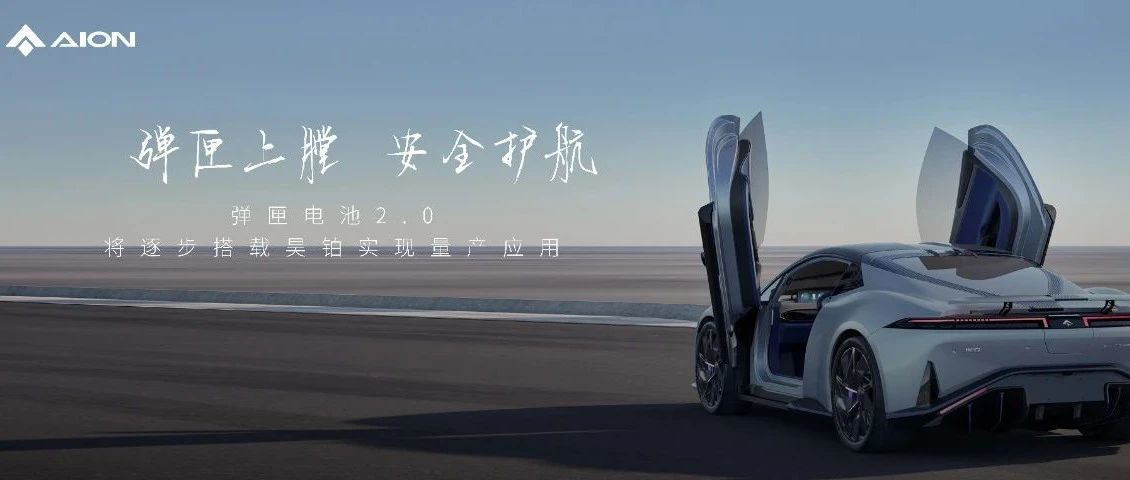On April 1st, EA unveiled its sales data for March, with a record-breaking 40,016 units sold for the first time. EA stated that it has entered a new phase of scale effect.
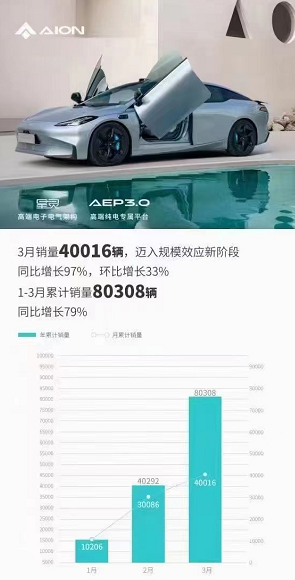
What makes EA so outstanding? Emphasizing battery marketing is an essential aspect.
In March 2021, EA launched its first-generation cartridge battery pack technology, along with a ternary lithium cartridge battery pack needle puncture test, achieving no ignition for the entire pack.
In an era when puncture tests on individual battery cells were being widely debated, EA took a different approach by conducting puncture tests on the battery pack instead.
The results proved that puncture tests on battery packs, compared to those on battery cells, were more valuable in drafting industry standards and more meaningful for consumers purchasing cars.
Since the launch of cartridge batteries, EA has revealed that 400,000 EA vehicles equipped with cartridge batteries have been sold, with a striking record of zero spontaneous combustion incidents.
On March 30th, EA once again focused on battery safety by launching Cartridge Battery 2.0 technology and successfully completing a gunshot test of lithium iron phosphate cartridge battery 2.0 technology, achieving no ignition and no explosion.
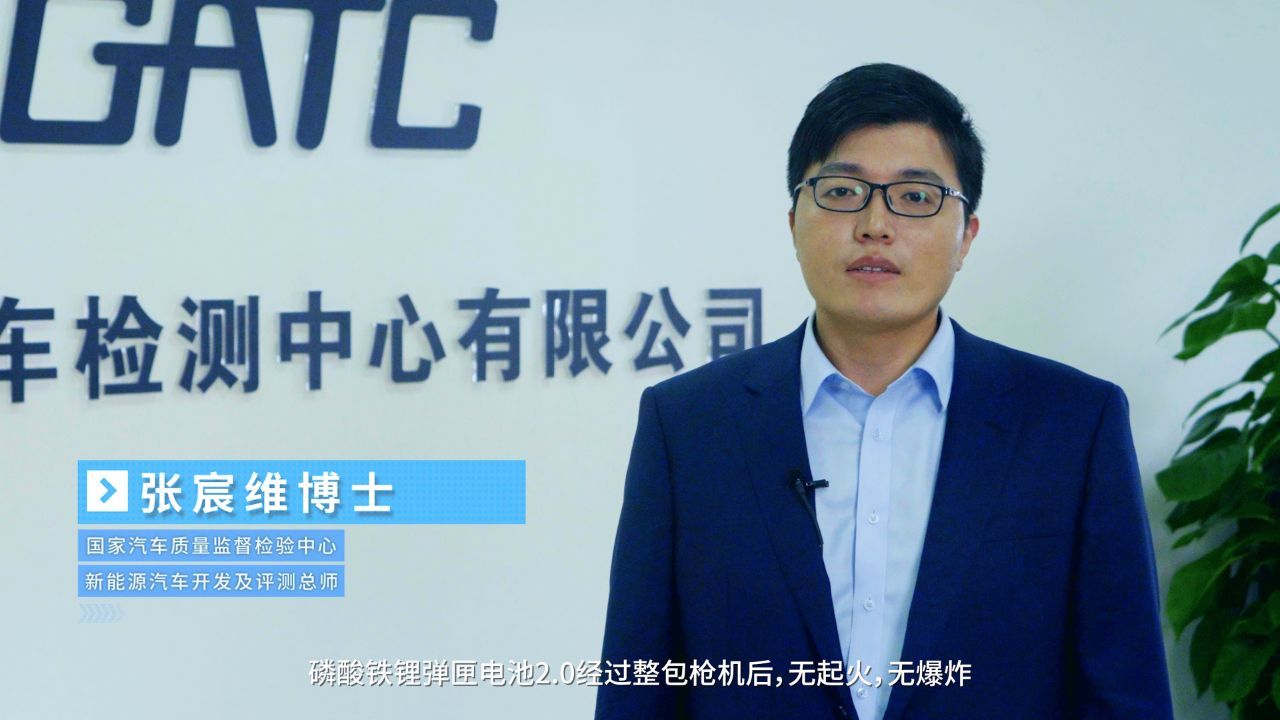
EA stated that if the previous cartridge battery’s needle puncture test was “climbing Mount Everest,” the current Cartridge Battery 2.0 gunshot test is akin to “manned moon landing,” redefining the new standard for battery safety.
What is a gunshot test?
Battery gunshot tests are relatively unknown.
According to EA’s definition, a gunshot test involves shooting a fully charged battery pack with a reserved shooting opening from a distance of 15 meters. EA states that the gunshot test is the most stringent battery safety test to date, simulating even more extreme scenarios.
So, how stringent is it?
It’s reported that, compared to the already rigorous needle puncture test, during a gunshot test, when a bullet penetrates the battery cell, the speed can reach 975,000 times that of a puncture, and the wound diameter is 7-8 times that of a puncture. The test can instantly penetrate multiple battery cells, causing thermal runaway and explosive destruction.Translate the below Markdown Chinese text into English Markdown text, maintaining the professional manner, keeping the HTML tags in Markdown, and only output the result:
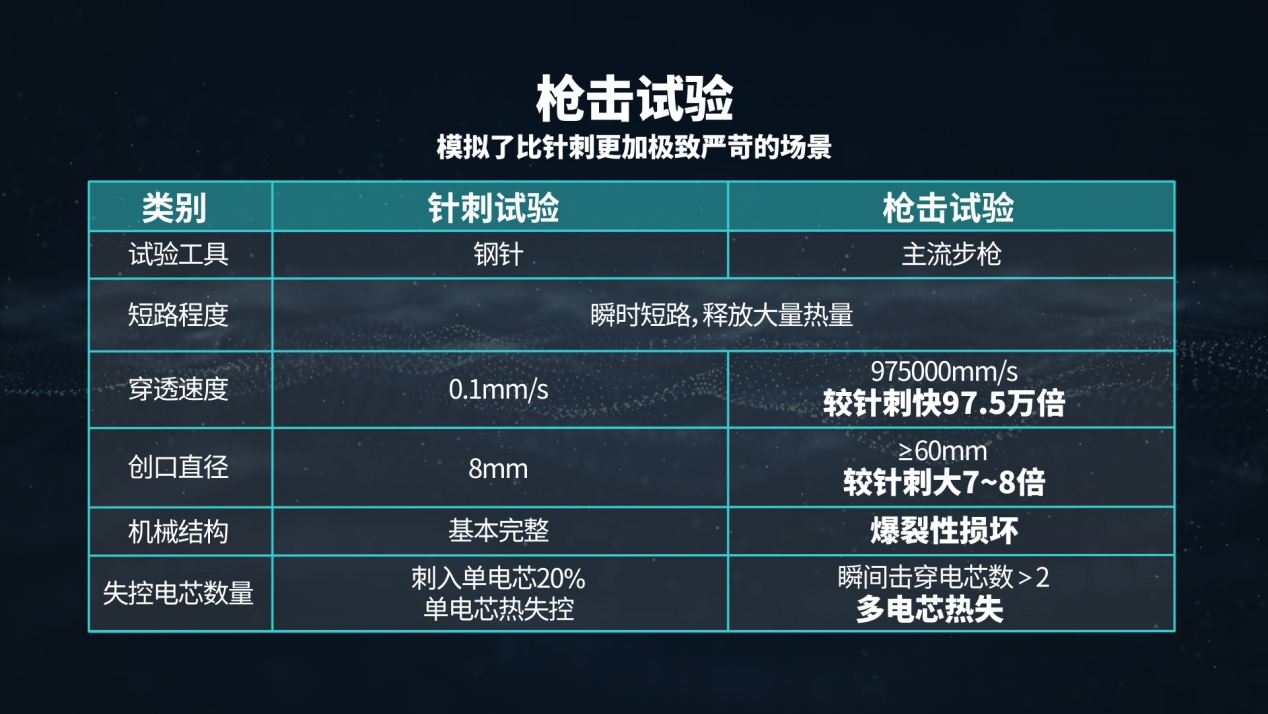
At present, Eeon has conducted gunshot tests on Lithium Iron Phosphate Battery Cassette 2.0, same as the previous stabbing test, three comparisons were made: mainstream lithium iron phosphate single cells in the industry, mainstream lithium iron phosphate modules in the industry, and Lithium Iron Phosphate Battery Cassette 2.0.
As a result, the first two both experienced significant thermal runaway and combustion, while the Battery Cassette 2.0 did not catch fire or explode.

According to Eeon, after the gunshot test, the Battery Cassette 2.0 pack emitted smoke, with the highest temperature of adjacent affected cells at 185°C, and no thermal runaway. Upon opening the battery system casing, only 3 cells had mechanical structural explosion damage. After resting for 24 hours, the voltage dropped to 0V, and the temperature returned to room temperature, with no fire or explosion.
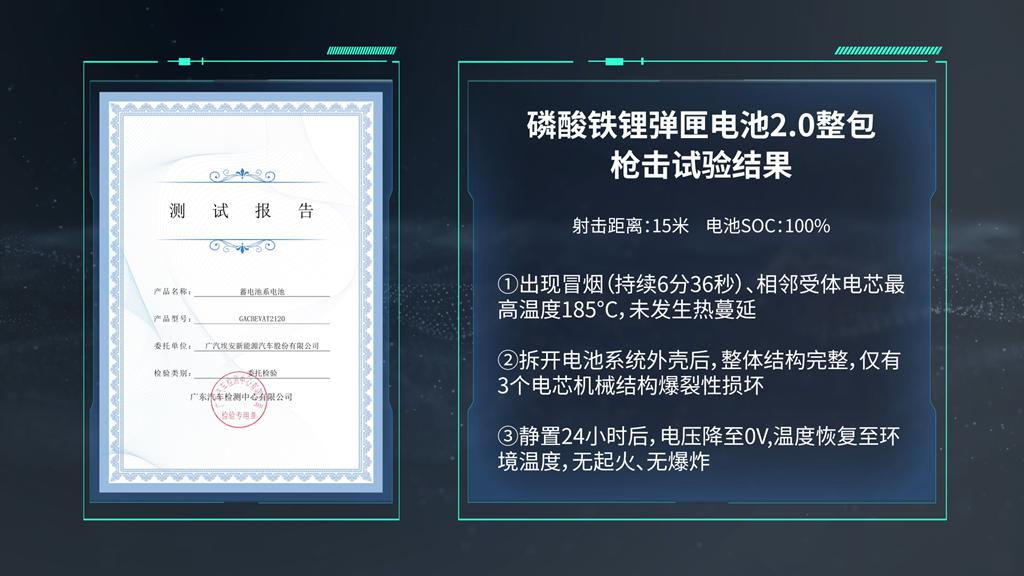
Eeon stated that this is also the first time globally that a power battery has achieved no fire and explosion in a gunshot test.
Why does Eeon conduct gunshot tests?
Battery Cassette 2.0, by passing the gunshot test, demonstrates increased safety. However, other batteries that have not undergone gunshot tests, or are preparing for gunshot tests, do not necessarily indicate that they are unsafe; otherwise, everyone would not be so unfamiliar with gunshot tests, and the real meaning is open to debate.
Moreover, the safety of a battery is never determined by a single test but rather the comprehensive capabilities of battery design, manufacture, and testing.
Battery Cassette 1.0 is already safe enough.
In addition to “400,000 vehicles, 0 self-ignition”, Wang Qingquan, director of Eeon battery R&D, also revealed some data: currently, Eeon cars equipped with Battery Cassettes have safely driven more than 300 million hours, more than 10.1 billion kilometers, and safely charged 68 million times.Translate the Chinese Markdown text below into English Markdown text, maintaining the professional tone and retaining the HTML tags in Markdown. Only output the result.
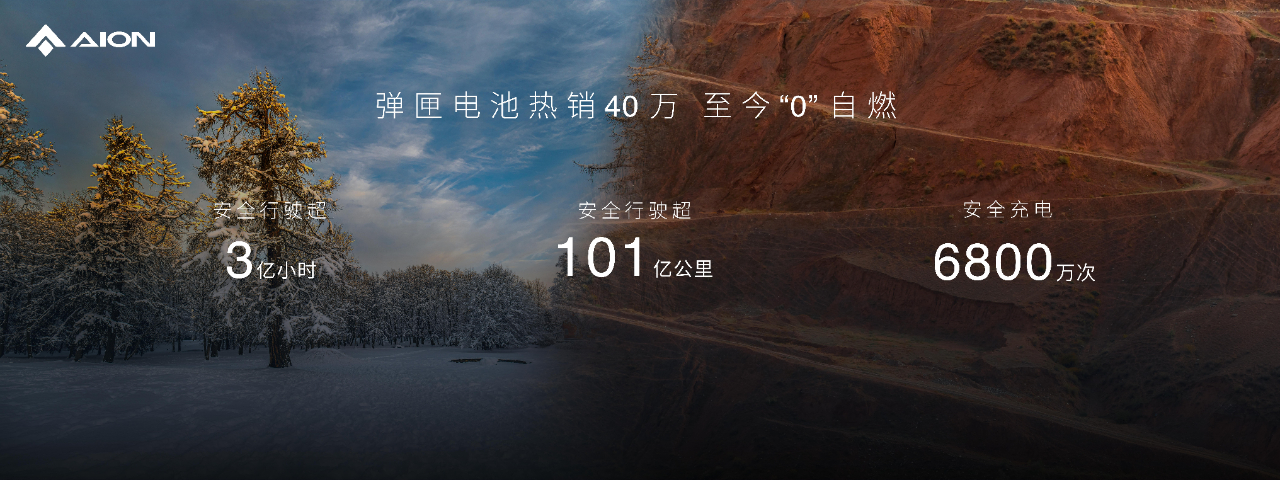
Perhaps compared to Nissan’s “600,000 units, 0 self-ignition,” AEEAN may still be a step behind, but when it comes to other new energy brands, it is definitely more secure.
Since Magazine Battery 1.0 is already secure enough, why did AEEAN launch Magazine Battery 2.0 and even conduct a so-called gunshot test?
Judging from AEEAN’s explanation, it is primarily for technical reasons. AEEAN stated that the gunshot test solved the battery safety issues under extreme conditions, such as multi-cell instantaneous short-circuits and explosive breakages.
Of course, we do not rule out marketing considerations. AEEAN continued to introduce Magazine Battery 2.0 for two reasons, shared by Wang Qingquan:
First, safety is AEEAN’s deep-seated belief;
Second, as evidenced by self-ignition data from the National Emergency Management Department in recent years, battery safety remains an industry pain point and challenge.
Given the successful launch and market performance of Magazine Battery 1.0, introducing Magazine Battery 2.0 was a natural progression.
Magazine Battery 2.0 Technical Highlights
Magazine Battery 1.0 consists of four core technologies, including ultra-high heat-resistant cells, an ultra-strong heat-insulated battery safety cabin, a rapid cooling system, and an always-on, fifth-generation battery management system.
Magazine Battery 2.0 builds on Magazine Battery 1.0 and introduces a series of innovative safety technologies, especially ultra-stable electrode interfaces, heat-resistant phase-change materials, and a cell extinguishing system:
Regarding the ultra-stable electrode interface.
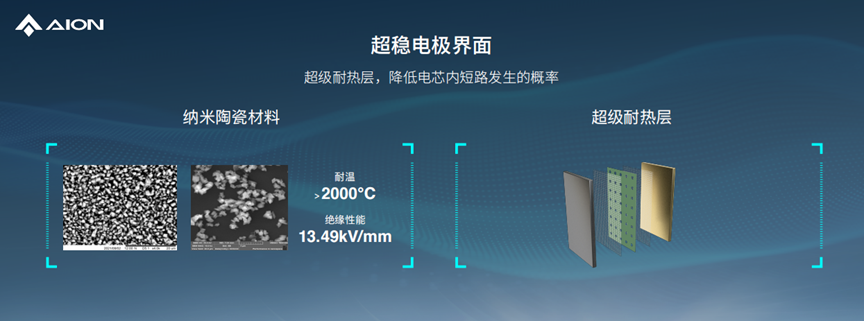
The electrode interface is the area with the highest activity inside the cell. To enhance the stability of the electrode interface, Magazine Battery 2.0 developed the “Ultra-Stable Electrode Interface” technology, which has three main technical points:
First, ultra-high stability and ultra-high heat resistance nano-ceramic materials are used to significantly increase the toughness of the electrode interface;
Second, the application of composite current collector materials allows for rapid collapse during heat concentration, avoiding continuous short-circuits;
Third, Magazine Battery 2.0’s electrolyte is enhanced with oxidation-resistant flame retardants, which, when activated at high temperatures, can capture free radicals from combustion reactions, cutting off the conditions for sustained burning.
Aulton states that with the triple-technology protection, even if the battery cell experiences thermal runaway, its temperature increase rate can be reduced by 20%.
Regarding thermal insulation phase change materials.

In addition to improving the intrinsic safety of the batteries, Aulton has collaborated with the China Aerospace to develop thermal insulation phase change materials with dual insulation and phase change heat absorption functions.
Reportedly, the phase change latent heat of this material is 10 times higher than that of conventional materials, allowing it to absorb a substantial amount of heat while maintaining a constant temperature. Combined with lattice nano-insulation materials, the overall insulation performance is increased by 40%.
Regarding the cell fire extinguishing system.
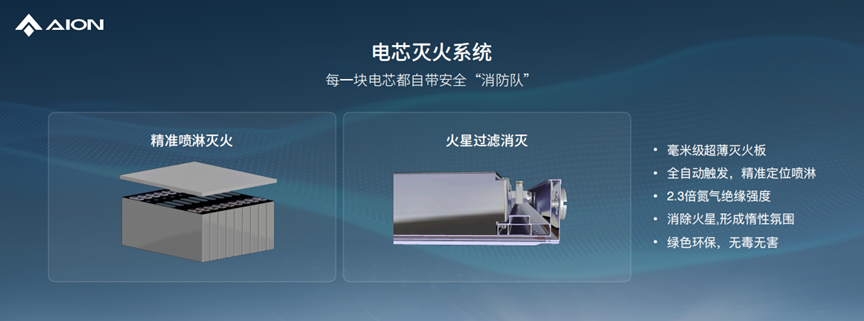
In response to extreme scenarios where the entire battery pack may be damaged due to external factors, Aulton engineers equipped Magazine Battery 2.0 with a cell fire extinguishing system.
This system uses a low melting point alloy to form a fire-extinguishing chamber, enabling the storage of fire-extinguishing agents, self-positioning of thermally runaway cells, and targeted sprinkling in a very small vertical space. When a cell experiences thermal runaway, a large amount of fire-extinguishing agents are instantly and accurately sprayed onto the cell.
The fire-extinguishing agent can not only vaporize while absorbing heat but also capture free radicals from combustion chain reactions, forming an inert gas atmosphere. Combined with Aulton’s thermal runaway gas emission treatment technology, this eliminates sparks and 99.5% of PM10 from exhaust.
Aulton states that this technology makes Magazine Battery 2.0 the only battery technology with a built-in safety “fire brigade.”
On the other hand, Magazine Battery 2.0 features a dual-layer cooling system that cools both the top and bottom of the battery cell, improving overall cooling efficiency by 80% while reducing the upper shell temperature by 75%, further ensuring the safety of passengers above the battery pack.In addition to the aforementioned passive battery safety technology, Ean has developed the sixth-generation cloud-based battery management system based on big data and AI technology.
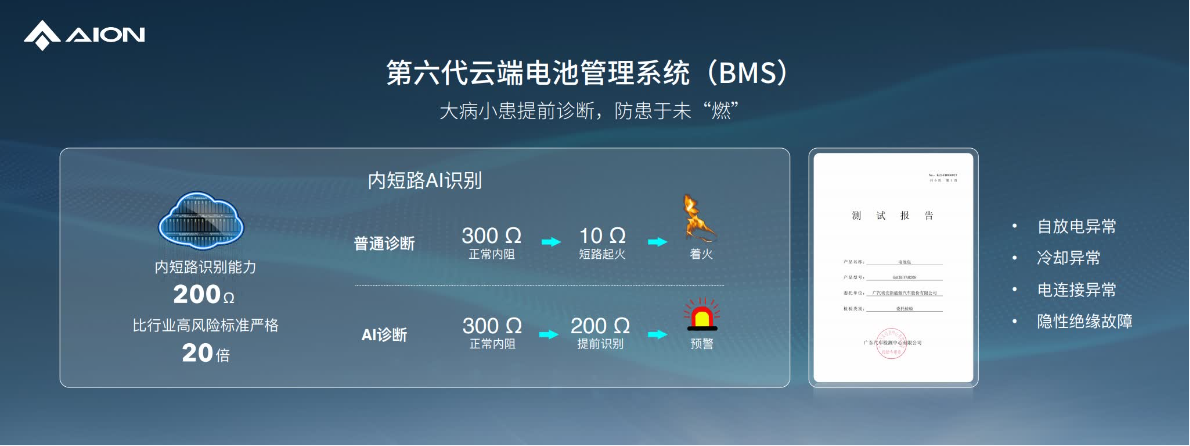
Thanks to over 600,000 vehicles and 1,300TB of full lifecycle application data, the sixth-generation cloud-based battery management system significantly improves the identification capabilities for faults such as abnormal self-discharge, abnormal cooling, electrical connection anomalies, and latent insulation failures. The AI recognition ability for internal short circuits has reached 200Ω, far exceeding the 10Ω risk line, enabling early diagnosis and prevention before ignition.
Ean claims that the application of these technologies has increased the comprehensive thermal runaway management capabilities of the Magazine Battery 2.0 by five times, allowing it to withstand the impact of simultaneous thermal runaway from multiple battery cells.
Application of Magazine Battery 2.0
In September last year, Ean officially launched its new high-end brand, Hyper Haoplatinum, and introduced the brand’s first model – China’s first supercar, Hyper SSR. The first batch of Hyper SSRs went offline for testing in December last year and are currently in the mass production validation stage.
Hyper GT is the second mass-produced vehicle from the Haoplatinum brand. Last month, Ean announced that preorders for Hyper GT will begin this month, with plans to launch in May, deliveries starting in June, and an estimated price of 300,000 yuan.
Ean stated that the Magazine Battery 2.0 will be implemented first in the Haoplatinum brand models, with a high probability of being applied to Hyper GT.
Ean also mentioned that Magazine Battery 2.0, as a whole package battery technology, can be matched with long-range and ultra-fast charging battery technologies. It will not only be progressively deployed in Haoplatinum for mass production but also demonstrate ultimate battery safety performance, empowering continuous evolution in fields such as deep diving, aviation, and aerospace, and accelerating energy transition.
“The image of a battery being shot is very shocking. If the battery can withstand such extreme thermal runaway scenarios like gunfire, it can truly provide peace of mind during daily driving,” said Qiu Liangping, from Ean’s Brand Communications Department. He added, “Safety is deeply ingrained in Ean’s belief system. Soon, we will conduct whole-package gunfire tests on ternary lithium batteries to quickly address users’ battery safety concerns. Stay tuned!”请提供您想要翻译的Markdown中文文本,这样我才能为您提供改进后的英文版本。
This article is a translation by ChatGPT of a Chinese report from 42HOW. If you have any questions about it, please email bd@42how.com.
